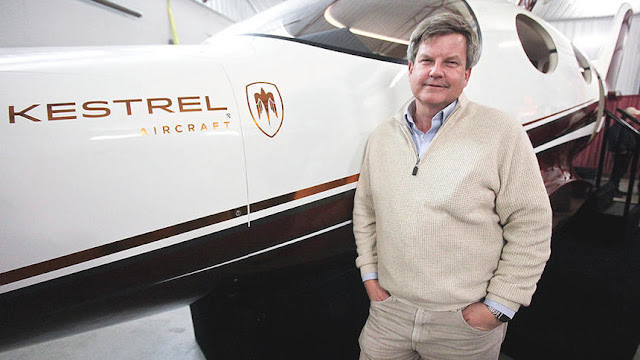Alan Klapmeier, then president and CEO of Kestrel Aircraft, stands in March 2013 with a mockup of the aircraft in a hangar at the Bong Airport in Superior.
A fledgling aircraft parts manufacturing company promising to establish a facility at the Grand Rapids airport is in line for a $1.5 million loan from the Iron Range Resources and Rehabilitation Board.
IRRRB staff members have asked the agency’s board to approve the loan to Albuquerque, N.M.-based ACC Manufacturing Inc., which makes composite parts for its parent company, One Aviation.
The board, which will meet Monday in Eveleth, also is being asked to approve another $293,000 to the Grand Rapids Economic Development Authority for improvements at the ACC site.
The money will buy an existing hangar at the airport to house about 20 employees of ACC, said state Rep. Tom Anzelc, DFL-Balsam Township, who is IRRRB board chairman.
The company eventually would relocate to a larger facility at the airport as part of a $9 million project.
One Aviation is the parent company producing the Eclipse jet and also hoping to produce the Kestrel turboprop aircraft. It’s headed by Alan Klapmeier, the former Duluth aviation executive who co-founded Cirrus Aircraft.
“We’re hoping this will be Phase One of a much larger project that will lead to the manufacture of the entire airplane in Grand Rapids,” Anzelc said.
The parts made in Grand Rapids would be used in the Eclipse jet, which is already in production in New Mexico, said Mark Phillips, IRRRB director. But Phillips agreed that the long-term goal is to see One Aviation build its Kestrel plant at Grand Rapids as well.
“This is a specific, standalone deal to supply the Eclipse,” Phillips said. “No one is hiding the fact we’d like to someday see them build the Kestrel on the Iron Range. But this project isn’t tied to that.”
Klapmeier originally planned to build the Kestrel in Brunswick, Maine, where the company now has a parts facility. The company then joined with Wisconsin Gov. Scott Walker in 2012 to announce the Kestrel would be built in Superior. State and local agencies pledged some $100 million in loans, grants, tax breaks and tax credits. The company said it would create up to 600 jobs at the plant in Superior’s industrial park, with Walker celebrating the project as part of his effort to create jobs in the state.
But Klapmeier said that while Kestrel remains based in Superior, the state of Wisconsin never came through with the package of incentives promised and has muddied the project for more than four years.
“Superior has been great to work with. It’s still a great community for this project. There is still some hope it could happen in Wisconsin. It’s a small possibility it could still be Superior. But the state just hasn't been there for us,” Klapmeier told the News Tribune on Thursday.
State officials, for their part, told Wisconsin Public Radio last year that Kestrel faced challenges raising money and meeting requirements to receive financing under federal programs.
The company has about 25 employees in Superior. The company also had been using some leased warehouse space from Bent Paddle Brewing Co. in Duluth but recently lost that space.
“It’s that work and some additional work that’s moving to Grand Rapids. We lost our lease and had to find more space,” Klapmeier said.
Until now, many of the composite parts for the Eclipse have been made by subcontractors in far-flung locations. Klapmeier said he wants to bring that work into the company and into the Northland.
“I think it’s better business sense for us to make our own composite parts. And I think northern Minnesota is the right place for workforce compatibility, workforce productivity. ... We know Minnesota. This is where we live,” said Klapmeier, who has a home outside Cloquet and a cabin outside Iron River.
Klapmeier said he wants to have private financing lined up for Kestrel before deciding on a location for the plane’s production plant. In the meantime, he said One Aviation is focused on bringing Eclipse and a second-generation Eclipse jet to full production and market before refocusing on Kestrel.
Anzelc said the Grand Rapids project has been well-vetted, noting Klapmeier began meeting with Iron Range officials more than a year ago at the Capitol in St. Paul.
“It’s a very complex project. It’s not fully an IRRRB deal. Grand Rapids is taking the lead and we are essentially helping them out. We’re a partner. There will be other partners,” Anzelc said. “This has been a slow, deliberate process. It’s been a long time unfolding.”
In addition to Klapmeier as CEO, One Aviation lists Ken Ross as president, Ed Underwood as CFO and Steve Serfling, a Deer River native, as executive vice president.
The Eclipse 500 is a small six-seat business jet in the works since the mid-2000s. The Albuquerque-based company started fast but entered Chapter 11 bankruptcy in 2008 and was liquidated in 2009 before being reformed as Eclipse Aerospace, which merged with Klapmeier’s Kestrel Aircraft to form One Aviation in April 2015.
The Kestrel 350 is an all-composite, single-engine turboprop aircraft in the works for several years. It is planned to carry up to eight people at high speed over long distances and designed to be “far more versatile” than jet aircraft, and “burn less fuel, and be able to maintain approach speeds at large busy airports yet land on short, grass or gravel strips,” according to the company’s website.
The Kestrel plane doesn't yet have Federal Aviation Administration certification to begin production or sales.
Klapmeier has had an ongoing feud with Duluth-based Cirrus, which he co-founded with his brother, Dale, since leaving the company in 2009; a legal dispute about expenses stemming from a lawsuit filed against Cirrus and initially won by Klapmeier — but then overturned on appeal — is now being decided by the Minnesota Supreme Court.
Source: http://www.superiortelegram.com



































